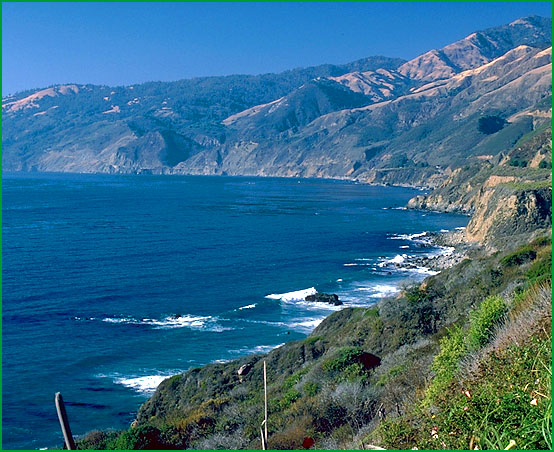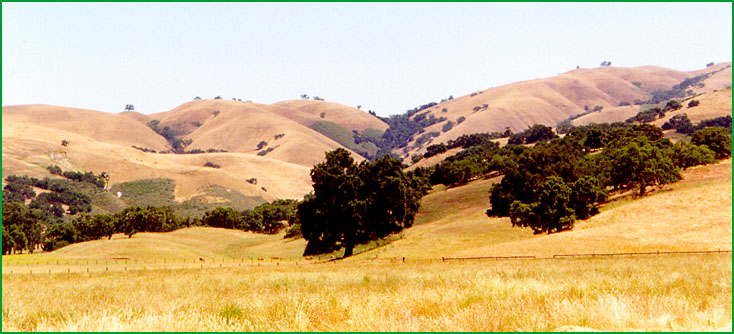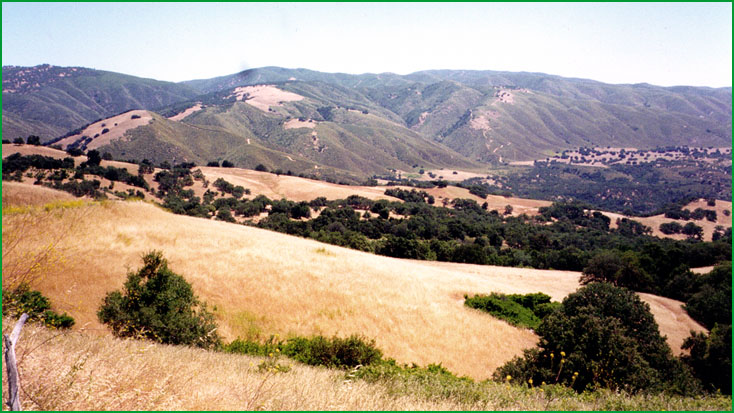 | Subsection J - North Coastal Santa Lucia Range |
coastal part Ś Robert Ettner |
Carmel Valley watershed Ś Patsy Miles |
west of Greenfield Ś Scott Miles |
west of Greenfield Ś Patsy Miles |
http://www.fs.fed.us/r5/projects/ecoregions/261aj.htm
This subsection is the northern part of the Santa Lucia Range. It is on the coastal side of the mountain range, between the Salinas Valley and the Pacific Ocean. The climate is hot to temperate and subhumid to humid, and is modified greatly by marine influence. MLRAs 4c, 14d, 15c, and 15d.
Lithology and Stratigraphy. This subsection is mostly on the Salinian Block, between the San Andreas and Nacimiento faults. It is predominantly Mesozoic granitic and pre-Cretaceous metamorphic rocks. There is some Cretaceous sedimentary rock of the Great Valley Sequence, considerable Miocene marine sediments, and some other Tertiary sediments. Also, there are some rocks of the Franciscan Complex on the southwest edge where the subsection crosses the Sur-Nacimiento fault zone.
Geomorphology. This is a subsection of northwest trending mountains with rounded ridges, steep sides, and narrow canyons. Remnants of marine terraces are present along the coast and nonmarine terraces on the Monterey Peninsula, but they are not extensive. The subsection elevation range is from sea-level up to 5862 feet on Junipero Serra Peak. Mass wasting and fluvial erosion are the main geomorphic processes.
Soils. The soils are mostly shallow Typic Xerorthents, Entic and Pachic Ultic Haploxerolls, and Pachic Argixerolls. On Cretaceous and Miocene sedimentary rocks they are Lithic Xerorthents and Calcic and Pachic Ultic Haploxerolls.
Typic Natrixeralfs and Ultic Palexerolls are present on nonmarine terraces on the Monterey Peninsula. The soils are well drained, and most of them are leached free of carbonates. The soil temperature regimes are mostly thermic, mesic at higher elevation, and some isomesic near the coast.
Soil moisture regimes are mostly xeric, and possibly some ustic.
Vegetation. The predominant natural plant communities are Douglas-fir - tanoak series, with some Redwood series in canyons on the southwest side of the subsection; Coast live oak series on north-facing and California sagebrush - black sage series on south-facing slopes near the northwest end of the Santa Lucia Range and inland; Canyon live oak series on steep canyon sideslopes; and Chamise series and Live oak shrublands on shallow soils inland and at higher elevations. There are smaller amounts of Blue oak series adjacent to the Salinas Valley, Valley oak series in Carmel Valley, California sagebrush series and California oatgrass series near the ocean, and with some Mixed conifer series at higher elevations. Monterey pine series on the Monterey Peninsula and Santa Lucia fir series on the coastal side of the mountain range are not extensive but are of special interest.
Characteristic series by lifeform include:
Grasslands: California annual grassland series, California oatgrass series, Montane meadow habitat, Purple needlegrass series.
Shrublands: Black sage series, Blue blossom series, California sagebrush series, Chamise series, Chamise - bigberry manzanita series, Chamise - black sage series, Chamise - wedgeleaf ceanothus series, Coyote brush series, Deer brush series, Coyote brush - black sage series, Coyote brush - California sagebrush series, Eastwood manzanita series, Holdiscus series, HooverÆs manzanita series, Montane wetland shrub habitat, Rubber rabbitbrush series, Scrub oak series, Wartleaf ceanothus series, Wartleaf ceanothus - chamise series, Wedgeleaf ceanothus series, Woollyleaf manzanita series.
Forests and woodlands: Bishop pine series, Black oak series, Blue oak series, California bay series, California buckeye series, California sycamore series, Canyon live oak series, Coast live oak series, Coulter pine series, Coulter pine - canyon live oak series, Douglas-fir - tanoak series, Gowen cypress stands, Interior live oak series, Knobcone pine series, Mixed oak series, Monterey cypress stands, Monterey pine series, Ponderosa pine series, Redwood series, Santa Lucia fir series, Tanoak series, Valley oak series, White alder series.
Climate. The mean annual precipitation is about 16 to 60 inches. It is practically all rain, except for some snow on at higher elevations. Mean annual temperature is about 50░ to 58░ F. The mean freeze-free period is about 225 to 300 days.
Surface Water. Runoff is rapid and all but the larger streams and streams in the southwest part of the subsection are generally dry during the summer. Streams on the seaward side of the mountains may be perennial.
There are no lakes in the subsection.



